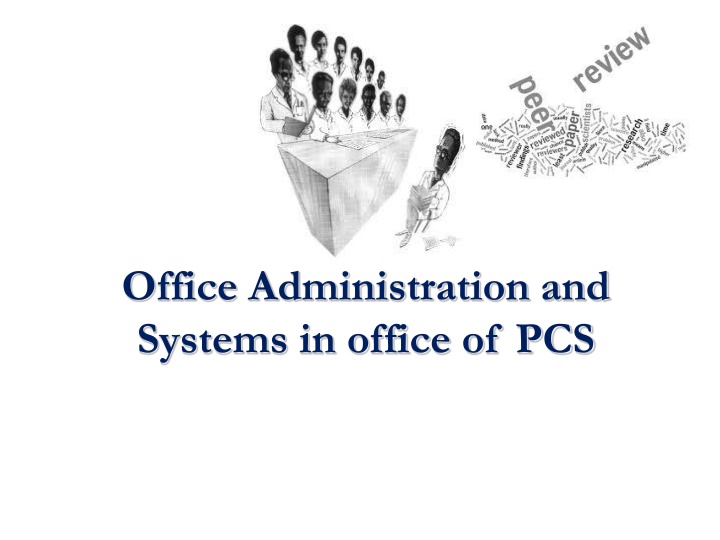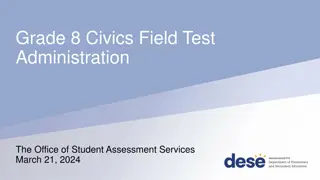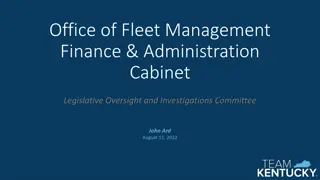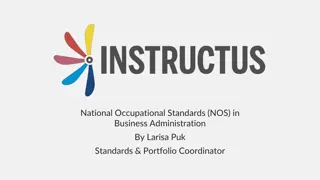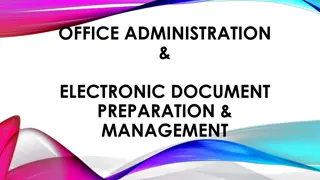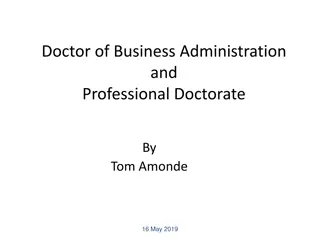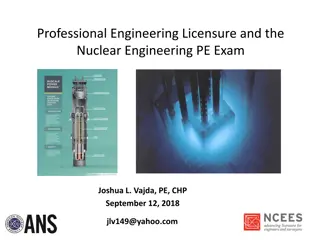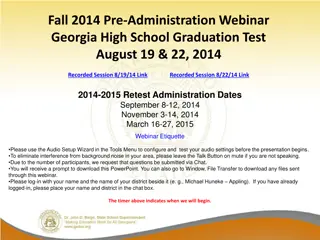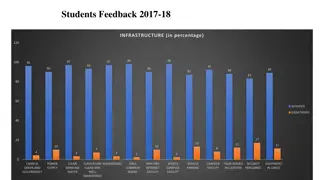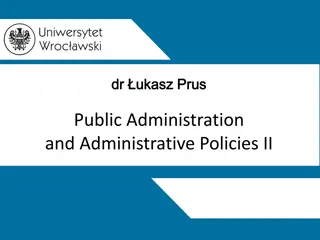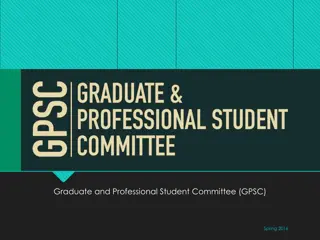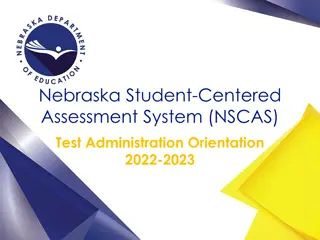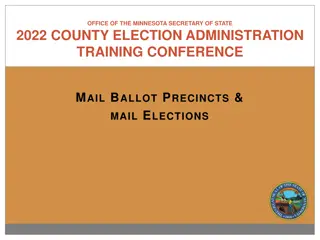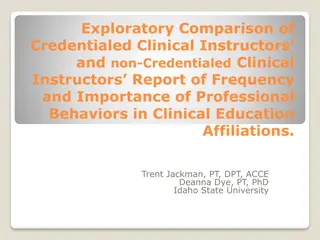Importance of Office Administration and Systems in a Professional Setting
Office administration and systems are crucial for the smooth and effective functioning of any organization, including a Professional Practice Unit. They involve management of employees, resources, infrastructure, and following systematic procedures to provide quality services, ensure compliance with laws, and stay updated with industry standards. Implementing methodologies like 5S can further enhance workplace organization and efficiency.
Download Presentation

Please find below an Image/Link to download the presentation.
The content on the website is provided AS IS for your information and personal use only. It may not be sold, licensed, or shared on other websites without obtaining consent from the author.If you encounter any issues during the download, it is possible that the publisher has removed the file from their server.
You are allowed to download the files provided on this website for personal or commercial use, subject to the condition that they are used lawfully. All files are the property of their respective owners.
The content on the website is provided AS IS for your information and personal use only. It may not be sold, licensed, or shared on other websites without obtaining consent from the author.
E N D
Presentation Transcript
Office Administration and Systems in office of PCS
Office Administration It organisation, irrespective of its size & nature as well as the area of operations. is an essential feature to any No activity could be organized without systems, procedures and rules. It is a set of day-to-day activities within an organization. 2
Office Administration FOCUS Management of employees Ensure adequate resources needed for continuous productive results Overseeing the day to day operations In a PCS office specifically focuses - to ensure providing quality services to the satisfaction of the clients - to ensure technical standards achieved in compliance of law - to keep abreast the latest amendments and changes of law with constant knowledge updation as a tool. 3
Office Administration- Resources Work Area- appropriate infrastructure Information Technology hardware, software, website etc. Communication facility Proper furniture, lighting, ventilation, a/c etc. Toilet, dining and refreshment facility Library (e-library) required books and reference materials Compliance checklists, templates, specimens Manpower 4
System System is doing the things methodically by following certain procedures laid down with clearly defined roles and responsibilities for smooth and effective functioning of the office directly related to the volume and size of the Practice Unit. 5
Objectives Periodical methods ensure better performance with a minimum usage of time, effort, money and materials. Review: Improved work Facilitation: Usage of appropriate Office machines and equipments as well as facilities, adequate working conditions and good LIBRARY for reference. 6
5s Methodology 5S Workplace A Clean, Uncluttered & Well Organized Office Space Start 7
S1. Sort Non-essential items in the office space should be eliminated. S2. Shine Remove dirt & debris, inspect equipment & sources of contamination. eliminate 8
S3. Set in Order (a) Evaluate the office space & add smart office space features. (b) Create a well-ordered, visually instructive office space S4. Standardize Develop checklists, established environment that is visually instructive. standard & to procedures, mechanisms a other maintain work 9
S5.- Sustain Monitor, expand & refine 5S results An office space should be one that restores order, regulates activity & improves automatically continuously 10
Office Administration- Combination Office administration is now a combination of Infrastructure, Information technology, Human resource management, Office resource management, Written communication, Verbal communication, Research and Training, Budgeting 11
Infrastructure- work area should have appropriate infrastructure viz. proper ventilation, furniture, lighting etc. Information Technology- Latest Hardware, Software and Networking necessary to keep up with the professional expectations. Regular back up of important files, documents and diary/working papers. Maintenance and updation of website of PU. Human Resource Management- Adequate procedure for recruiting new employees and management trainees. Maintaining proper attendance record. Having disciplined environment. Training in interpersonal skills and communication skills. Assignment and rotation of work. Monitoring and accountability. Office Resource Management- Proper facility to have back up of data. 12
Office should be clean and hygienic, remove trash and avoid wastage. Ensure easy retrieval. Reduce redundancy. Communication- written and verbal There should be proper system for recording inward/outward mails. Maintenance of confidentiality of client and firm information. Training employees and apprentice trainees to be well behaved and polite. No important communication to be done verbally. Research & Training- requires regular and continuous updation and training on amendments and new laws. Budgeting- Planning the area of expense, ensure proper utilization and application of resources etc. 13
CONCEPT OF ENGAGEMENT TRAILS & ENGAGEMENT DIARY 14
INTRODUCTION Maintenance of proper records is a very significant and indispensable part of office systems and procedures. Thus in a PCS office, Engagement Trails and maintenance of diary becomes significant while carrying out attestation services. 15
ENGAGEMENT TRAILS A relevant chronological record showing who has done and what operations he or she has performed during a given period of time. Trail also details what are the data and records referred and relied upon. It also facilitates future reference and tracking. Audit trails are useful both for maintaining security recovering lost transactions 16
ENGAGEMENT TRAIL is a form of documentary evidence that can be used to trace transactions to their source to verify their validity and accuracy. 17
ENGAGEMENT DIARY An important tool in the hands of the PU and his team. Shall provide information on the following Who - who has carried out the engagement Where - where has the engagement been conducted When - when is engagement undertaken What - what is purpose & scope of engagement 18
CONTENTS Contents of the diary Basic info of the name of the company Information about the PU Scope & objective of the engagement being carried out Conflict of interest, if any Changes in terms of engagement, if any Records and documents verified and inspected Methodology of carrying out Period of engagement Documents requested, obtained and relied upon 19
Files management - ensures control at the file level Files management ensures that records relating to a specific activity or subject are securely maintained together in one file. This enables effective decision making and also ensures that the sequence of actions can be reconstructed, that is what happened, when, who did it, why. 21
Files management Filing involves *Arranging records according to a simple, logical system * Placing records in a storage container in correct sequence *Retrieving the records so that they can be used 22
good filing systems contain complete and comprehensive files thereby enabling effective decision making provide integrity and continuity regardless of changes in personnel facilitate protection and preservation of records provide low cost and efficient maintenance of records reduce the possibility of misfiling and reduce duplication mean less time spent searching for files and documents 23
Files management Filing systems Filing Rules Files Equipment Computer Applications 24
CRITERIA of a good filing system Simplicity Flexibility / Expansibility Adaptability 25
Filing methods numerical alphabetic geographic form chronologic 26
Numerical System File units are placed in numerical sequence Originated from the registry system, used particularly in accessioning correspondences. Unsuited to handling name files. Ideally useful for case files (file units containing all documents pertaining to a particular transaction, usually developed in legal or business records. 27
Alphabetic System File units are placed in alphabetical sequence. First used to arrange records relating to persons, then gradually to records relating to subjects. The system may be modified to group records related by a common subject by: *standardizing subject headings *subdividing the main subject headings Other alphabetical filing systems are: *Alpha-numeric - uses letters to designate main subject headings and numerals for subordinate headings *Mnemonic - uses alphabetical symbols to denote subordinate headings. 28
Other Filing Systems Geographic Filing: files records by location or place first, followed by the name or subject. Forms : groups records according to their format or type (e.g. minutes, reports, invoices, receipts) Subject Filing: places records under subject classification. Chronologic Filing: files records by year, month, and date 29
Procedures in Filing indexing by card or register coding by writing symbols or captions, or highlighting indexed name or subject sorting by tray filing 30
Common filing problems too many filing places everybody a file clerk files disorderly; show no particular plan or arrangement system does not fit the way material is called for some records seem to belong under more than one category filing decisions erratic or inconsistent bulging folders accumulation of unnecessary or personal records 31
Common filing problems related records are filed under different categories the retrieval rate is poor (inability to locate the required document quickly) missing and misplaced documents mean too much time spent looking for files a high level of duplication exists users are setting up personal records systems incomplete files and backlogs of unfiled records exist filing cabinets are jammed with files bulging with documents 32
Improve your filing Begin each calendar year with a new set of files Files should not exceed thickness Dedicate time each week for filing to prevent backlog Avoid filing extraneous unnecessary duplicate copies Avoid tightly jammed files Safeguard access and confidentiality of records 33
Documentation and Record keeping w.r.t Audit Documentation shall take place throughout the audit process. Working papers shall be complete and appropriately detailed to provide a clear trail of the audit PU shall establish policies and procedures for retention of Audit Documentation Audit documentation shall be collated within a period of 45 days from the date of signing of Auditor s report. Audit documentation shall be maintained in physical or electronic form and retained for a period of 8 years from the date of signing of Auditor s Report. 34
Training Personnel receiving and opening mails placing mail/other papers in correct files extracting and replacing files opening/creating new files indexing & cross-referencing keeping a record of file movements retrieving lost/missing files destroying/disposing files retiring non-current files maintaining confidentiality 35
Thank you 36
